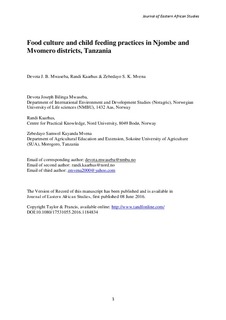Food culture and child-feeding practices in Njombe and Mvomero districts, Tanzania
Journal article, Peer reviewed
Permanent lenke
http://hdl.handle.net/11250/2401535Utgivelsesdato
2016Metadata
Vis full innførselSamlinger
Originalversjon
Mwaseba, D.J.B., Kaarhus, R. & Mvena, Z.S.K. (2016). Food culture and child-feeding practices in Njombe and Mvomero districts, Tanzania. Journal of Eastern African Studies, 10(2), 325-342. doi: 10.1080/17531055.2016.1184834Sammendrag
This article explores food culture and child-feeding practices, focusing on children below five years among the Bena and Luguru ethnic groups located in Njombe and Mvomero rural districts in Tanzania. In these two societies existing cultural norms, and beliefs related to child feeding focusing on breastfeeding and complementary feeding were investigated aiming at understanding how every-day practices on child feeding are socially and culturally constructed by actors including parents or guardians, thus giving cultural meanings that are attached to every-day realities on child feeding. The article is part of a larger research project whose overall purpose was to investigate the outcome of milk-based nutrition interventions involving dairy goat and cattle-keeping with the aim among others to improve health and nutritional status of family members, especially children below five years in societies where prevalence of malnutrition particularly undernutrition is rather high. Methods used included participant observation, in-depth interviews, focus group discussions and semi-structured interviews. Findings show that early after birth, pre-lacteal feeds are commonly introduced in both societies and the most common complementary food includes plain maize porridge. On the other hand, milk consumption among children was rather limited. Existing food habits and feeding practices seem to be informed by widely-shared norms and beliefs. However, these culturally established practices do not always meet the current international recommendations on child feeding. Besides, recommendations and nutritional information on child feeding have largely not been used as suggested. This paper argues that, for the successful introduction and implementation of nutrition-based interventions targeting children, it is important to identify and improve upon the indigenous child-feeding practices, reflecting existing food habits, food-related beliefs, and their meanings.
